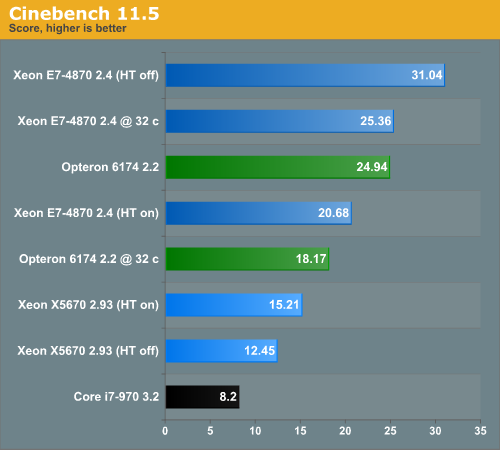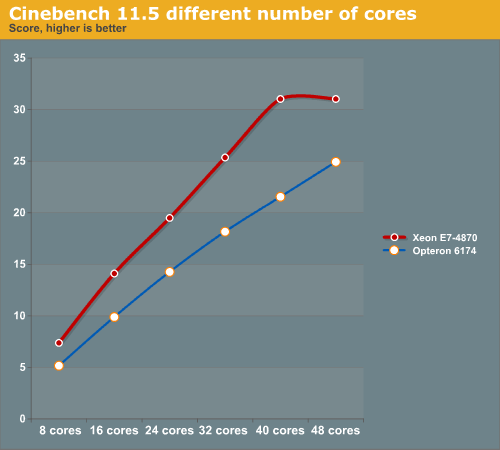Rendering and HPC Benchmark Session Using Our Best Servers
by Johan De Gelas on September 30, 2011 12:00 AM ESTCinebench R11.5
Cinebench, based on MAXON's software CINEMA 4D, is probably one of the most popular benchmarks around, and it is pretty easy to perform this benchmark on your own home machine. However, it gets a little bit more complicated when you try to run it on an 80 thread server: the benchmark only supports 64 threads.
First we tested single threaded performance, to evaluate the performance of each core.

A Core i7-970, which is based on the same "Westmere" architecture gets about 1.2 at 3.2GHz, so there is little surprise that a slightly lower clocked Xeon 5670 is able to reach a 1.15 score. It is interesting to note however that the Westmere core inside the massive Westmere-EX gets a better score than expected. Considering that Cinebench scales almost perfectly with clockspeed, you would expect a score of about 0.9. The E7 can boost clockspeed by 17% from 2.4 to 2.8GHz, while the previously mentioned i7-970 gets only an 8% boost at most (from 3.2 to 3.46GHz). And of course, the massive L3-cache may help too.
The Opteron at 2.2GHz performs like its Phenom II desktop counterparts. A 3.2GHz Phenom II gets a score of about 0.92, so we are not surprised with the 0.66 for our 2.2GHz core.
When we started benchmarking Cinebench on our Xeon E7 platform, we ran into trouble. Cinebench only supports 64 threads at the most and recognized only 32 of our 40 available cores and 80 threads. The results were pretty bad. To get a decent result out of the Xeon E7, we had to disable Hyper-Threading and we forced Cinebench to start up 40 threads. We included a Core i7-970 (Hyper-Threading on) to give you an idea of how a powerful workstation/desktop compares to these servers. This kind of software is run a lot on fast workstations after all.

Even cheap servers will outperform a typical single socket workstation by almost a factor of two. The quad socket machines can offer up to three or four times as much performance. For those of you who can't get enough: you can find some dual Opteron numbers here. The dual Opteron 6174 scores about 15, and a dual Opteron 2435 2.6 "Istanbul" gets about 9.
Cinebench scales very easily as can be noticed from looking at the 32 core and 40 core results of the Xeon E7-4870. Increase the core count by 25% and you get a 22.4% performance increase. The Opteron scales slightly worse. Compare the 48-core result with the 32 core one: a 50% increase in core counts gets you "only" a 37% increase in performance.
Below you can see the rendering performance of two top machines rendering with different numbers of cores.

You need about 48 2.2GHz Opteron cores to match 32 Xeon cores. The good news for AMD is that even these 8-core Westmere-EX CPUs are almost twice as expensive. That means that quad AMD Opteron 61xx systems are a viable choice for rendering, at least in CINEMA 4D (assuming it has the same 64-thread limitation as Cinebench). AMD has carved out a niche here, which is one reason why there will be cheaper 4 socket Romley EP systems in the near future.










52 Comments
View All Comments
MrSpadge - Friday, September 30, 2011 - link
Agreed - performance of a single i7 2600 can be hard to beat, depending on the application. My Matlab code uses all physical cores through the Intel Math Kernel Library, yet is ~30% slower on 2 x X5570 (wich is about the difference in clock speed, incidently).MrS
JohanAnandtech - Friday, September 30, 2011 - link
http://www.anandtech.com/show/4486/server-renderin...the core i970 3.2 GHz is included. But indeed, it has been some time since we have used backburner.
Is this the kind of bench you are looking for?
http://www.anandtech.com/show/2240/7
Backburner scales extremely well, so I suspect that especially the Quad MC Dell is a very good choice compared to a workstation.
JoeKan - Friday, September 30, 2011 - link
Yes - the backburner test is it. Although I use different rendering software, that test would be appropriate as the visualization rendering can properly represent real life usage and can stress the hardware at the same time.The test linked uses frames 20-29. I'd like to see a longer frame sequence.
The reason I asked that a workstation be used as a base reference is because that gives us, the readers, a point of reference to compare against. I define a workstation as a single CPU box anyone can build with off the shelf components, like a i7-2600K, or a i7-970 - a performance CPU in the $300+ to $600 range. That allows one to compare performance on a per $ basis.
Not a true 'workstation' as it does not use a Xeon, but it gives the ability to compare 'performance' to 'performance per buck' basis.
By using a $1000+ class CPU for comparison the 'bang for the buck' comparison is distorted.
xxtypersxx - Friday, September 30, 2011 - link
I love reading about the high end server hardware, its like F1 compared to road cars.As for benchmarks, may I suggest the linux x64 Folding at Home client? We know it scales past at least 128 cores without issue and as many of us that fold are running server hardware anyway, it will attract a new audience to the reviews.
rehm - Friday, September 30, 2011 - link
Hello,for CFD benchmarking you could also consider the code OpenFOAM. It scales very well and is gaining a lot of interest in industry and academia. Memory behaviour should be comparable to Fluent and it can be compiled with gcc and icc.
Regards
JohanAnandtech - Friday, September 30, 2011 - link
Very nice suggestion... but is there a sample solution/ benchmark we can measure? It is a bit hard for a hardware reviewer to come up with very specialized realworld tests :-).ozztheforester - Friday, September 30, 2011 - link
I am currently using a bunch of 2600k's for rendering in the past I used some dual xeon setups but only found those being extremely inefficient on cost/performance ratio. Can you please let us know the cost and power consumption of this system?currently getting around 8.72 points on cinebench 11.5 on a 2600k pc @4.5ghz which is consuming less than 200 watts at full load and costing a bit less than 800usd
also I would suggest using vray for multi thread benchmarks
sicofante - Friday, September 30, 2011 - link
Why didn't you set up a scene in Maya or Softimage and then render it with Mental Ray? THAT would be a professional test, Cinebench is not.BTW, no matter how powerful, these Xeon E7 systems are a no-go for studios. They are plainly anti-economical. You can have a much sensibler setup by putting ordinary Xeons or overclocked Core i7s in many racks, i.e., a rendering farm.
(Note: I build rendering farms for studios. Since 3D rendering grows almost linearly with frequency, what matters in the end is Euros/GHz, that is normalized GHz)
Phynaz - Friday, September 30, 2011 - link
What studio renders on overclocked desktop cpu's?confusis - Friday, September 30, 2011 - link
My studio does. We can't yet step up to a higher end multi-socket rendering server (finances, start-up company) so we make do with Phenom II x4's. A desktop box is good value for money at our end of the company scale. Once we grow we'll be looking at Interlagos however